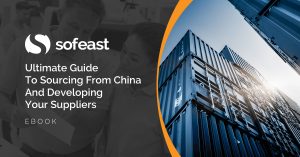When you work with a manufacturer in China, Vietnam, or India, do you wonder about the risks they run and whether they have insurance for manufacturers to protect against them?
If they are hit badly, and you depend on them for continuity of supply to your customers, both you and your customers may be hit badly too. (See an example in this article where Ford Motor Company evaluated the time to recover, and the financial impact if each of their suppliers’ operations is disrupted.)
Here are the 4 most common types of insurance manufacturers should generally look into.
1. Inventory and equipment insurance
This type of policy covers risks such as theft, fire, and other common events that will impact inventory and/or equipment. It is easy to understand. Maybe your home is covered by a similar type of insurance.
Imagine that, for some reason, the inventory purchased for your production disappears or burns. That kind of incident has pushed factories to bankruptcy. I would always recommend contracting such a policy.
In our experience, we have found that a low number of Chinese factories have such a policy, even though it is rather inexpensive. While the local government probably inspects them regularly for compliance with rules against the risk of fire, that risk hasn’t disappeared. And hiring a few guards, or placing locks on every door, doesn’t reduce the risk of theft to zero.
2. Product liability insurance
It covers cases where, for example, a user gets hurt by the product in an unintentional manner. The company that put the products on the market (the importer) faces litigation.
The risk is especially high with consumer electrical products, medical and pharmaceutical products, kids products, oil & gas equipment and installations, automotive parts (especially any part related to safety features), and so on. If you are buying/selling such ‘sensitive’ goods, you probably know you can be sued for millions of dollars/euros.
Unfortunately, finding an insurance company that accepts to provide such a policy can be difficult, or even impossible, for the manufacturer.
Large buyers force their suppliers to bear product warranty and to contract a product liability insurance. But that may not be realistic you buy less than 10 million USD a year from each supplier… And, the importer (not the factory) is generally the party that would get the payment from the insurance company.
I wrote about the way to set this up before, in case you can promise a substantial amount of business to a supplier:
-
Look for a contract manufacturer that has liability insurance issued by a reputable institution and with a very high claim limit
-
Double check that their policy would apply to your orders, including all cases where you want to be covered, and for a duration that makes sense for you (if you are in the US, it can mean more than 10 years)
-
Have them modify the policy so that your company is insured, too
-
Keep strict records about traceability in manufacturing and throughout the supply chain
-
Set up your own processes in case a recall is needed — you still want to be prepared and, among other things, (1) react quickly and communicate appropriately to interested parties, (2) minimize the financial burden, and (3) collect all the data that will allow for a successful claim.
What if you can’t be covered for product liability?
Start by taking preventive measures. On the factory’s side, the following certainly helps:
- A solid quality management system
- Traceability at least at the batch level, and a process to handle recalls
- A solid new product introduction process, including design reviews by independent & expert parties
And, always remember, as the importer you probably won’t be covered if the issue is clearly related to design instructions you gave to the manufacturer.
(When reviewing how consumer safety lawyers define design defects, I found they have no clue on this topic. In any case, you should assume that, if users get hurt, both the manufacturer and the importer will be blamed.)
3. Employer liability insurance
Manufacturers often employ hundreds (or more) people. They can contract a policy that covers their risks related to:
- Accidents
- Directors & officers’ liability: taxes, employees lawsuits…
- Loss of income (if they cannot operate because of some issue)
This is also easy to understand and is not specific insurance for manufacturers, but is useful in a factory setting.
4. Professional liability insurance
This is an interesting one that tends to be forgotten. If a manufacturer designs a product based on a customer’s specifications, a mistake is made, and the product is unusable. The manufacturer could be sued, in the absence of contract.
This is typically covered by a product development agreement (talk to a lawyer about this).
However, we still see a large number of OEM and ODM suppliers who are happy to work without such an agreement. (There is a simple reason for this: by default, all IP rights of the new products belong to them, even if all the inspiration for the design comes from the customer.) I can’t really comment on all the implications of such a situation, but I am fairly certain it leaves the supplier exposed to litigation.
*****
A discussion about insurance for manufacturers often comes up when a business continuity / disaster recovery plan is set up. Importers discover that their key suppliers have not given any thoughts to massive and predictable risks. Do you want to work with such suppliers?
Ultimate Guide To Sourcing From China And Developing Your Suppliers [eBook]
This FREE eBook starts from the beginning, discussing whether you need to hire a sourcing agent, and follows the sourcing process right through to developing a trusted supplier’s quality and productivity.
There are 15 chapters over 80+ pages to explore, providing exhaustive guidance on the entire sourcing and supplier development process from start to finish, including:
- Identifying suppliers,
- Negotiations,
- Quality inspections,
- Developing Chinese suppliers,
- Improving factory quality and productivity,
- and much more…


